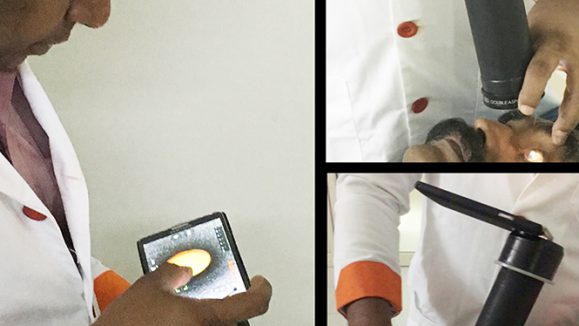The rise of smartphones – and the fact that nearly everybody owns one – has paved the way for innovations in remote diagnostics and in-home monitoring. And while we can argue that too much screen time is detrimental, these new technologies can help patients improve or maintain their vision. At PIE magazine, we’re forecasting that these – plus the other vision-improving devices presented during the recently held Digital Showcase at OIS@AAO 2019 – will flood the ophthalmic market in no time.
According to Linda Lam, the chief scientific and strategy officer for Ocutrx Vision Technologies (Irvine, CA, USA), ophthalmology has already been transformed by the digital revolution in imaging and AI, and it has the potential to augment telemedicine, personalized healthcare data, home healthcare, disease monitoring, screening, diagnosis and treatment.
“The future generation includes systems for in-home monitoring of visual acuity, visual field, and intraocular pressure; mobile fundus cameras have the potential to reach ophthalmic telemedicine so we can provide telemedicine in rural areas; and AI systems for diabetic retinopathy and visual field interpretation are really improving the efficiency of screening,” said Ms. Lam. She says current technology includes smartphone vision screening (with a clip-on adapter for retinal imaging) and virtual reality headsets to help magnify or help improve facial recognition.
She said this digitalization will be of particular importance to meet the challenges of rising costs and the changing demographics of an aging population: “This digital-health revolution provides compelling health-value propositions to all stakeholders, including the patients, physicians, payers and pharma.”
“Technology advancement could lead to controlling these healthcare costs, particularly in our field of ophthalmology,” continued Ms. Lam, adding that providers are using digital healthcare services in an effort to reduce inefficiencies, improve access, reduce cost and increase quality.
With an annual growth rate of 29% annually for digital healthcare, this is one innovation that is certainly a ‘haute’ priority in the future of ophthalmic screening, diagnostics and treatments – all designed to tackle the rising challenges faced by both patients and healthcare providers.
Digitalization isn’t a future trend – it’s here now – and it’s certain to impact the way both patients and physicians operate. To address its opportunities and impacts, several healthcare leaders offered their insight during the Healthcare Leaders’ Perspectives: Opportunities and Challenges discussion, moderated by James Mazzo, the global president of ophthalmic devices for Carl Zeiss Meditec (Jena, Germany). Mr. Mazzo asked the panel to discuss not what’s happening now – but what’s happening in the next three to five years . . .
“I think the digital revolution is already here – and yes, it will change the way doctors practice,” said Michael Kaschke, PhD, president and CEO, ZEISS Group, adding that the fundamental job of a doctor interfacing with a patient will not change, rather how this interface is going to happen will change.
“First, digitalization will make the healthcare industry more efficient – there’s no way around it. And the second, essentially by higher patient education, the ability of every person to interface with a health professional and to get a better understanding of his or her health – these are basically the two effects that will change.”
Regarding digitalization, Peter McDonnell, MD, William Holland Wilmer Professor and director, John Hopkins School of Medicine, Wilmer Eye Institute said that “our belief is that if it’s the right thing for the patient, if it’s a good thing for the patient, then it’s a good thing. Definitely, it’s a learning process, trying to do the right thing with encryption and protecting patient data to help ensure it won’t get misused. But we’ve got to develop these protocols rapidly – particularly for the younger patients who have an expectation when it comes to responsiveness”.
He elaborated further on one key demographic: “Younger patients are connected, they expect to be able to send us an email, they want to schedule without talking to a person, and they don’t want to hear that the doctor doesn’t have an opening for the next six months. They want to be part of the process with the doctor, they don’t just want to hear the doctor talk. So hopefully, it’s a great opportunity for the young doctors to embrace this new way of doing business,” he said.
According to Ashley McEvoy, EVP, worldwide chairman, medical devices at Johnson & Johnson (New Brunswick, NJ, USA), when there’s high consumer engagement, there seems to be really good disruption of innovation – with lower engagement it’s slower. “Technology can be our friend to say ‘get more engaged in the lifetime value of your eyes’,” she explained.
“Technology can enable more of that connective experience, and we’re in the early days and I think that technology can enable a transformation in ophthalmology… things like enabling better telemedicine, that’s a really good thing for patients… it’s not a replacement but rather complementary.”
Meanwhile, David Pyott, the former chairman and CEO, Allergan (Dublin, Ireland), provided some examples of how digitalization can improve the current healthcare system. “The big idea is what I call stratification of care,” he said. “Imagine a scenario of someone who’s been in the ICU and they get discharged and sent home. That patient at home with those monitors can be monitored by a machine and filter out what needs to be looked at by a healthcare professional.” Certainly, this saves valuable time, money and effort for both patient and doctor.
Indeed, the innovations seen at OIS@AAO will help style the future of treatment and patient outcomes in ophthalmology . . . and we’re looking forward to seeing more of these trending technologies in the near future.
Editor’s Note: A version of this article was first published in PIE Today, PIE Magazine’s electronic daily congress news, Media MICE’s daily at the Ophthalmology Innovation Summit (OIS) held alongside AAO 2019 in San Francisco, California.



